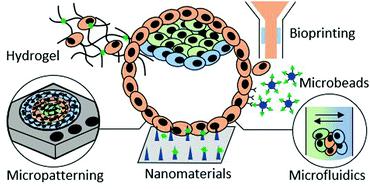当前位置:
X-MOL 学术
›
Biomater. Sci.
›
论文详情
Our official English website, www.x-mol.net, welcomes your feedback! (Note: you will need to create a separate account there.)
Biomaterials-based approaches to model embryogenesis
Biomaterials Science ( IF 6.6 ) Pub Date : 2020-10-26 , DOI: 10.1039/d0bm01485k Chantelle Spiteri 1, 2, 3, 4 , Valeria Caprettini 1, 2, 3, 4 , Ciro Chiappini 1, 2, 3, 4, 5
Biomaterials Science ( IF 6.6 ) Pub Date : 2020-10-26 , DOI: 10.1039/d0bm01485k Chantelle Spiteri 1, 2, 3, 4 , Valeria Caprettini 1, 2, 3, 4 , Ciro Chiappini 1, 2, 3, 4, 5
Affiliation

|
Understanding, reproducing, and regulating the cellular and molecular processes underlying human embryogenesis is critical to improve our ability to recapitulate tissues with proper architecture and function, and to address the dysregulation of embryonic programs that underlies birth defects and cancer. The rapid emergence of stem cell technologies is enabling enormous progress in understanding embryogenesis using simple, powerful, and accessible in vitro models. Biomaterials are playing a central role in providing the spatiotemporal organisation of biophysical and biochemical signalling necessary to mimic, regulate and dissect the evolving embryonic niche in vitro. This contribution is rapidly improving our understanding of the mechanisms underlying embryonic patterning, in turn enabling the development of more effective clinical interventions for regenerative medicine and oncology. Here we highlight how key biomaterial approaches contribute to organise signalling in human embryogenesis models, and we summarise the biological insights gained from these contributions. Importantly, we highlight how nanotechnology approaches have remained largely untapped in this space, and we identify their key potential contributions.
中文翻译:

基于生物材料的胚胎发生模型
了解,繁殖和调节人类胚胎发生的基础细胞和分子过程,对于提高我们概括具有适当结构和功能的组织的能力以及解决导致先天缺陷和癌症的胚胎程序失调至关重要。干细胞技术的迅速出现使人们能够使用简单,强大且可访问的体外模型在了解胚胎发生方面取得巨大进展。生物材料在提供时空组织生物物理和生化信号的过程中起着中心作用,这些时空组织是体外模拟,调节和解剖进化中的胚胎生态位所必需的。这种贡献正在迅速改善我们对胚胎形成机制的理解,从而使人们能够开发出更有效的再生医学和肿瘤学临床干预措施。在这里,我们重点介绍了关键的生物材料方法如何有助于组织人类胚胎发生模型中的信号传递,并总结了从这些贡献中获得的生物学见解。重要的是,我们强调了纳米技术方法在此领域仍未得到充分开发,并确定了它们的关键潜在贡献。
更新日期:2020-11-03
中文翻译:

基于生物材料的胚胎发生模型
了解,繁殖和调节人类胚胎发生的基础细胞和分子过程,对于提高我们概括具有适当结构和功能的组织的能力以及解决导致先天缺陷和癌症的胚胎程序失调至关重要。干细胞技术的迅速出现使人们能够使用简单,强大且可访问的体外模型在了解胚胎发生方面取得巨大进展。生物材料在提供时空组织生物物理和生化信号的过程中起着中心作用,这些时空组织是体外模拟,调节和解剖进化中的胚胎生态位所必需的。这种贡献正在迅速改善我们对胚胎形成机制的理解,从而使人们能够开发出更有效的再生医学和肿瘤学临床干预措施。在这里,我们重点介绍了关键的生物材料方法如何有助于组织人类胚胎发生模型中的信号传递,并总结了从这些贡献中获得的生物学见解。重要的是,我们强调了纳米技术方法在此领域仍未得到充分开发,并确定了它们的关键潜在贡献。



























 京公网安备 11010802027423号
京公网安备 11010802027423号